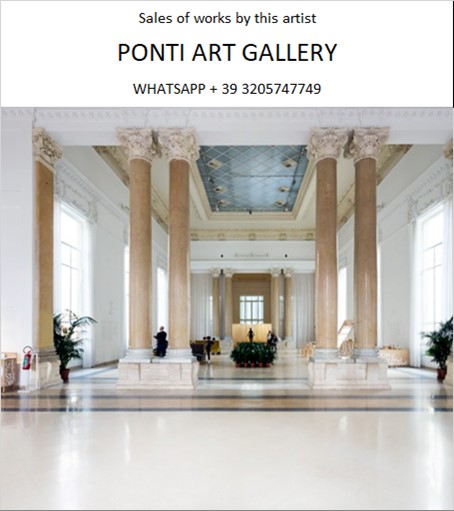Ponti Art Gallery is interested in buying and selling works
of art by this artist.

Edgar-Alwin Payne Biography
Edgar Alwin Payne was an American painter whose work epitomized the spirit of the American West and captured the raw beauty of its landscapes. Born on March 1, 1883, in Washburn, Missouri, Payne's early life was rooted in the rural setting of the Ozarks. This environment instilled in him a profound appreciation for nature that would become the cornerstone of his artistic endeavors.
From a young age, Payne demonstrated a strong inclination towards art, but his formal education was limited. At the age of 14, he left home to travel across the United States and Mexico, supporting himself through various jobs, including painting signs, stage sets, and houses. Despite his lack of formal training, Payne was determined to become a painter. His journey eventually led him to Chicago, where he briefly enrolled at the School of the Art Institute of Chicago in 1907. However, he found the structured environment of the institute stifling and left after only two weeks, choosing instead to be self-taught and to rely on practice and his own sense of direction.
Payne's early career was marked by struggle, but he persevered, exhibiting small easel paintings at the Palette and Chisel Club in Chicago. His talent began to gain recognition, and he supplemented his income with occasional mural work. In 1909, at the age of 26, Payne made his way to California for the first time, where he was captivated by the state's diverse landscapes. He spent several months painting at Laguna Beach before heading to San Francisco, where he met fellow artist Elsie Palmer. The two artists shared a mutual passion for art and eventually married on November 9, 1912, after a courtship that included a postponed wedding ceremony to capture the perfect morning light.
Payne's artistic career flourished in California. He became a central figure in the state's burgeoning art scene, particularly in Laguna Beach, where he was instrumental in forming the Laguna Beach Art Association and became its first president in 1920. His favorite subject, the California Sierra Nevada Mountains, inspired some of his most famous paintings. Payne's love for the Sierras was so profound that a lake in Humphrey's Basin was named after him, a testament to his impact on the region.
Throughout his career, Payne won numerous awards and exhibited his paintings successfully. His works can be found in important private collections and in museums such as the Laguna Art Museum, the Chicago Art Museum, the Southwest Museum of Los Angeles, and the National Academy of Design Collection. His paintings are characterized by bold, loose, and gestural brush marks, a mastery of color and values, and a deep understanding of compositional principles.
Payne's approach to painting was rooted in the belief that an artist should be a perpetual student of art. He emphasized the importance of mastering the fundamentals and having a clear purpose before beginning a painting. Payne's philosophy was that individuality and originality would naturally emerge from a deep understanding and application of artistic principles. He was skeptical of the pursuit of uniqueness for its own sake, arguing that true originality comes from creating new modes based on artistic fundamentals.
In 1941, Payne published "Composition of Outdoor Painting," a comprehensive guide to landscape composition that remains influential to this day. The book encapsulates Payne's artistic wisdom and his approach to painting, emphasizing the need for study, meditation, experimentation, and practice to achieve a painting with nobility in its concept and harmony in its composition.
Payne's life was a scenic journey, both literally and metaphorically. He traveled extensively, capturing the essence of the landscapes he encountered. His work resonated with a sense of adventure and a deep reverence for the natural world. Despite his travels, it was always California that fueled his artistic energy and provided the backdrop for his most iconic works.
As Payne neared the end of his life, he slowed down due to illness. He was diagnosed with cancer in 1946 and passed away on April 8, 1947. His legacy, however, continued to grow, with memorial exhibitions celebrating his contributions to American art. Payne's influence extended beyond his lifetime, as new generations of artists discovered his book and paintings, fostering a renewed appreciation for his scenic journey and the indelible mark he left on the world of landscape painting.
Edgar-Alwin Payne Quotes and
Sales of Works
Ponti Art Gallery selects and deals with paintings by the
artist. Upon request, we provide free estimates and
evaluations, communicate prices, quotations, and current
market values.
If you are interested in BUYING or SELLING works by the
artist, contact us immediately.
If you wish to sell or receive an evaluation of the
works:
Send us a frontal photo of the painting, one of the back,
and one of the signature. Also, indicate the dimensions of
the work. Inform us about the purchase origin of the work
and any kind of available documentation (purchase
receipts, certificates of authenticity, publications). One
of our operators will respond to you on the same day. We
guarantee maximum confidentiality and extreme
professionalism.
If you wish to purchase works by the painter: Contact us
and let us know your request. We will inform you about the
available works. We also offer the possibility to
subscribe to our NEWSLETTER, through which you will be
informed at the beginning of each month about the latest
acquisitions of the art gallery.
You can send us pictures of the work:
